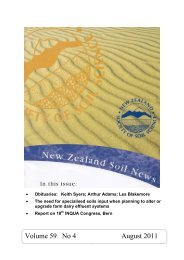Download - New Zealand Society of Soil Science
Download - New Zealand Society of Soil Science
Download - New Zealand Society of Soil Science
Create successful ePaper yourself
Turn your PDF publications into a flip-book with our unique Google optimized e-Paper software.
Abstract<br />
Increasing atmospheric CO 2 concentrations are expected to affect ecosystems processes, and while a<br />
<strong>New</strong> <strong>Zealand</strong> study reported a response in soil biological activity after 4 years <strong>of</strong> CO 2 enrichment,<br />
apparently reflecting increased populations <strong>of</strong> Longidorus elongatus, similar findings have not been<br />
reported from other sites. <strong>Soil</strong> micr<strong>of</strong>auna in 0–10 cm soil under a sheep-grazed pasture on a sand was<br />
assessed quarterly in FACE rings that were either at ambient CO 2 or had been exposed to 475 μl l -1<br />
CO 2 for some 9 years. Although the area had been subject to a severe drought and micr<strong>of</strong>aunal<br />
populations were lower than previously found, the effects <strong>of</strong> elevated CO 2 on micr<strong>of</strong>aunal populations<br />
were broadly similar to those at 4 years. Average populations <strong>of</strong> the root-feeding Longidorus<br />
elongatus increased from 67,000 to 233,000 m -2 (3.48×) compared with a 4.26× increase after 4 years,<br />
microbial-feeding nematodes increased slightly, while predacious nematodes showed a 2.0× increase.<br />
A pot experiment showed an additive effect <strong>of</strong> elevated CO 2 and L. elongatus abundance in reducing<br />
specific root length. That similar effects have been found 4 and 9 years after CO 2 enrichment<br />
commenced suggests they are real, and emphasises the difference to other sites around the world<br />
where much lower responses to elevated CO 2 have been found. This, in part, reflects the unique<br />
combination <strong>of</strong> soil, plant and soil biological conditions at each site and confirms the strong effect <strong>of</strong><br />
soil type and vegetation on soil biological processes. Just as the effects <strong>of</strong> global climate change on a<br />
given region are idiosyncratic, so it seems are the effects <strong>of</strong> elevated CO 2 on soil and ecosystem<br />
processes. In part, this reflects our limited understanding <strong>of</strong> below-ground processes.<br />
Biology and Fertility <strong>of</strong> <strong>Soil</strong>s 45,799-808, 2009<br />
______________________<br />
Interpretation <strong>of</strong> pre-AD 472 Roman soils from physicochemical and<br />
mineralogical properties <strong>of</strong> buried tephric paleosols at Somma<br />
Vesuviana ruin, southwest Italy<br />
Yudzuru Inoue A , Jamsranjav Baasansuren B , Makiko Watanabe C , Hiroyuki Kamei D , and David J. Lowe E<br />
A<br />
Center <strong>of</strong> Advanced Instrumental Analysis, Kyushu University, 6-1 Kasuga- kouen,<br />
Kasuga, Fukuoka 816-8580, Japan. B Center for Global Environmental Research, National Institute for<br />
Environmental Studies, 16-2 Onogawa, Tsukuba, Ibaraki 305-8506, Japan. C Graduate School <strong>of</strong> Urban<br />
Environmental <strong>Science</strong>s, Tokyo Metropolitan University,1-1, Minami-Osawa, Hachioji, Tokyo 192-0397,<br />
Japan. D Graduate School <strong>of</strong> Information <strong>Science</strong> and Engineering, Tokyo Institute <strong>of</strong> Technology, 2-12-1<br />
Ookayama, Meguro-ku, Tokyo, 152-8552, Japan. E Department <strong>of</strong> Earth and Ocean <strong>Science</strong>s, University <strong>of</strong><br />
Waikato, Private Bag 3105 Hamilton, <strong>New</strong> <strong>Zealand</strong> 3240<br />
Abstract<br />
This study aimed to interpret soil fertility around Somma Vesuviana in ancient Rome from<br />
investigation <strong>of</strong> buried paleosols developed beneath thick pumice deposits <strong>of</strong> the AD 472 Pollena<br />
eruption <strong>of</strong> Mt. Vesuvius. Two buried pedons derived mainly from phonolitic tephra deposits <strong>of</strong> the<br />
AD 79 Pompeii eruption, and ancient construction waste, were excavated and sampled at the Somma<br />
Vesuviana villa ruins on the northern flanks <strong>of</strong> Mt. Vesuvius, Italy. For comparison, a buried paleosol<br />
on equivalent Pompeii tephra deposits in a nearby forest, and a modern soil on AD 1631 tephra<br />
deposits (compositionally similar to Pompeii eruptives) in an adjacent orchard, were similarly<br />
analyzed for physical, chemical, and mineralogical properties, including phosphorus fractions and<br />
primary mineral compositions. The two buried pedons in the ruin had abundant available P and K and<br />
contained moderate amounts <strong>of</strong> exchangeable cations. Leucite was the dominant primary mineral and,<br />
with alkali feldspars, is probably the major source <strong>of</strong> K in the buried horizons. A high content <strong>of</strong><br />
―authigenic P (Ca-bound P)‖ characterized all the pedons. We concluded that the buried Somma<br />
Vesuviana paleosols had a relatively high ability to supply nutrients and that they were fertile prior to<br />
the AD 472 eruption, although manuring to increase nitrogen was probably needed to maintain high<br />
productivity. Their physical properties such as water retention were probably enhanced by small but<br />
significant amounts <strong>of</strong> short-range order clays.<br />
Source: Geoderma (2009) 152, 243-251.<br />
180










